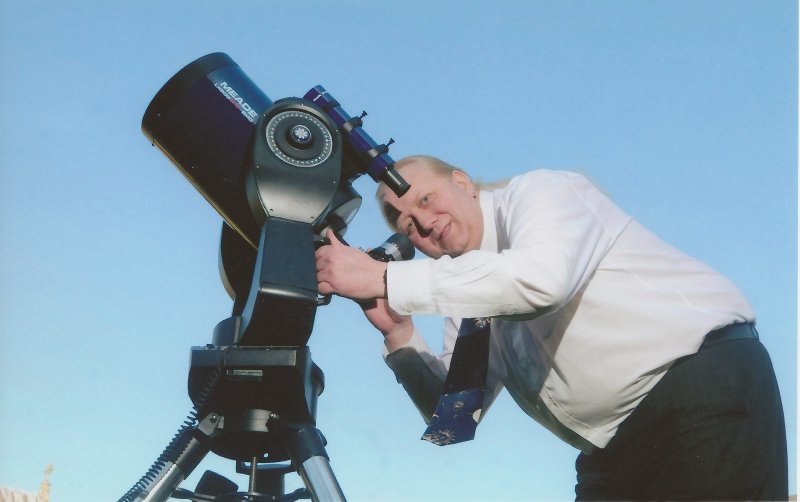
| Adrian Dening's |
| Stars Over Somerset |
|
Latest News
|
 |
Latest News
|
| My weekly articles about what can be seen in the night sky over Somerset are broadcast every Thursday to Sunday at various times, on Yeovil's local community radio station Radio Ninesprings. |
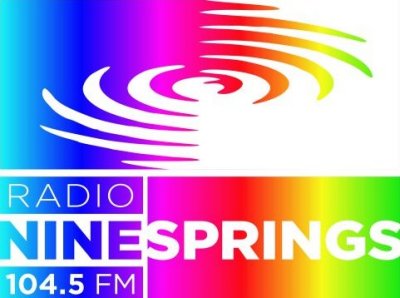 |
| Since 2022, Greg Perkins has been broadcasting the articles on Apple FM in Taunton. |
 |
| BBC Somerset also transmits Stars Over Somerset on Luke Knight's Friday evening show. |
 |
| Please click on the link below to hear the interview that I gave BBC Somerset: |
| Adrian Dening & Luke Knight Interview MP3 |
 |
| Monday 8th to Sunday 14th December 2025 |
|
Sunday 14th sees the peak of the annual Geminids meteor shower. If you look towards the east around 9pm, the bright star Procyon will be easy to spot, with planet Jupiter above it. To the right of them, more towards the south east, the constellation of Orion will be obvious and the brightest star in the night sky, Sirius, will be poking its head above the horizon. |
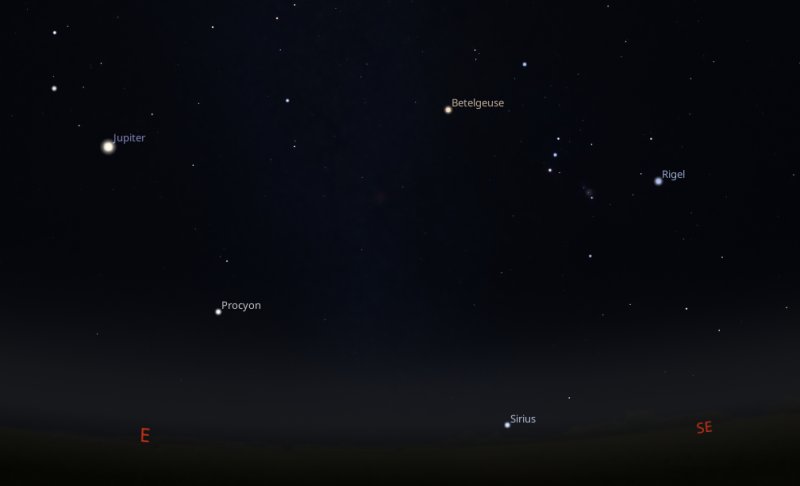 |
|
You should notice two bright stars just above Jupiter - these are Castor and Pollux - the "heads" of the twins in the constellation Gemini. |
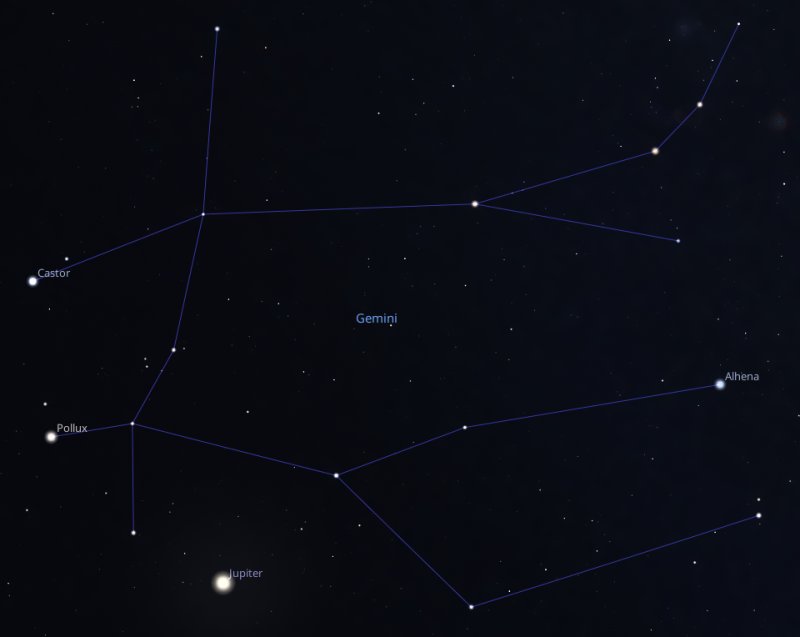 |
|
The radiant point of the meteor shower, where the shooting stars appear to originate from, will be just above Castor. |
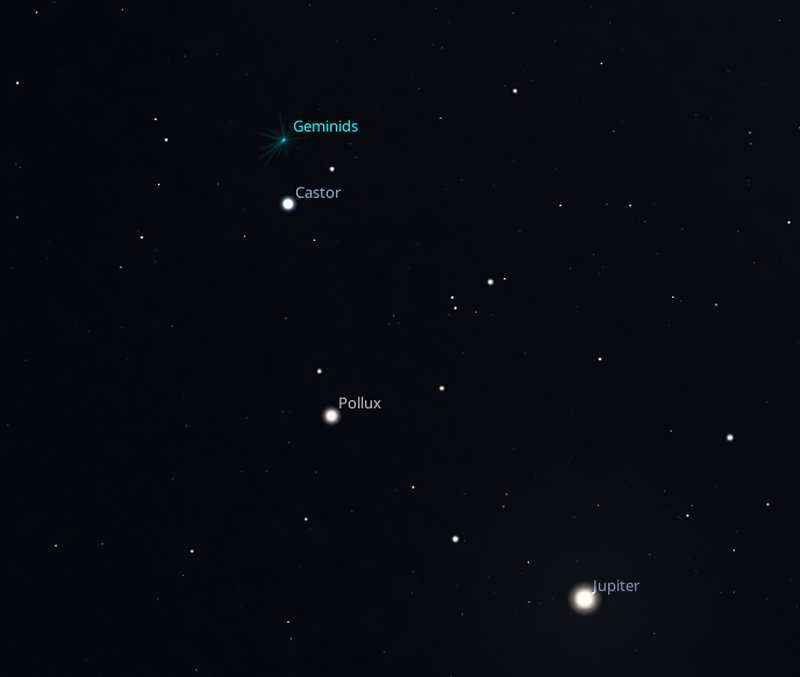 |
|
At its peak, the shower has been known to produce up to 120 meteors per hour, as the bits of space debris enter our atmosphere at a speed approaching 70Km per second. This debris is normally associated with the leftovers of different comets because they melt and produce a "tail" as they approach the Sun, on their long journey from the outer reaches of the Solar System. The Geminids is a little unusual, in that these meteors originate from an Asteroid called Phaethon that is in a highly elliptical orbit in and out of the Asteroid Belt. Being an asteroid, Phaethon is rocky, where your average comet is more like a dirty snowball! |
|
So could some of these bits actually get through the atmosphere without burning up completely and crash into the Earth? If they did, they would be called meteorites, but that's not going to happen as they are only tiny to start with. Something the size of a grain of sand could produce a decent shooting star! |
| Monday 1st to Sunday 7th December 2025 |
|
If you missed the shadow of Jupiter's moon Ganymede being cast on the planet's surface last week, there is another opportunity to witness it from 6am on the morning of Tuesday 2nd. At that time, Jupiter will be located towards the west and you will only have a little window of opportunity before dawn. |
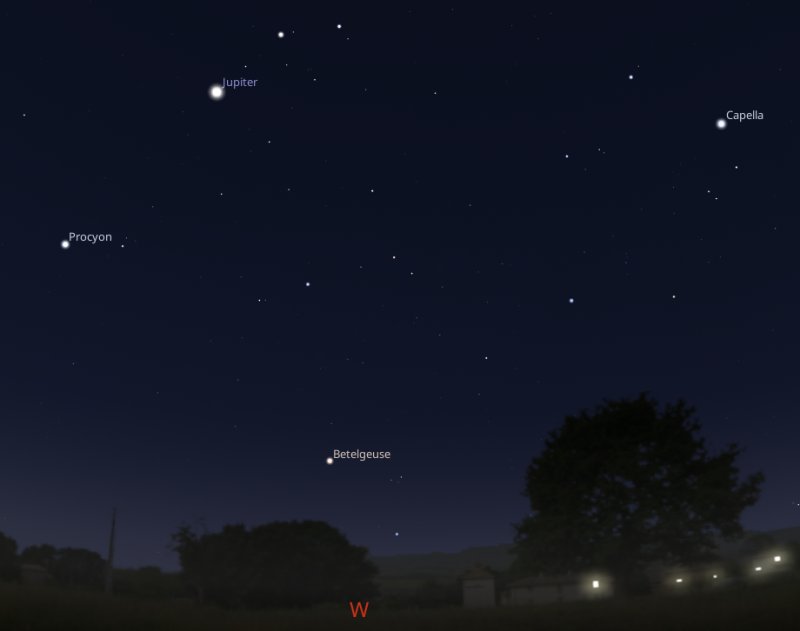 |
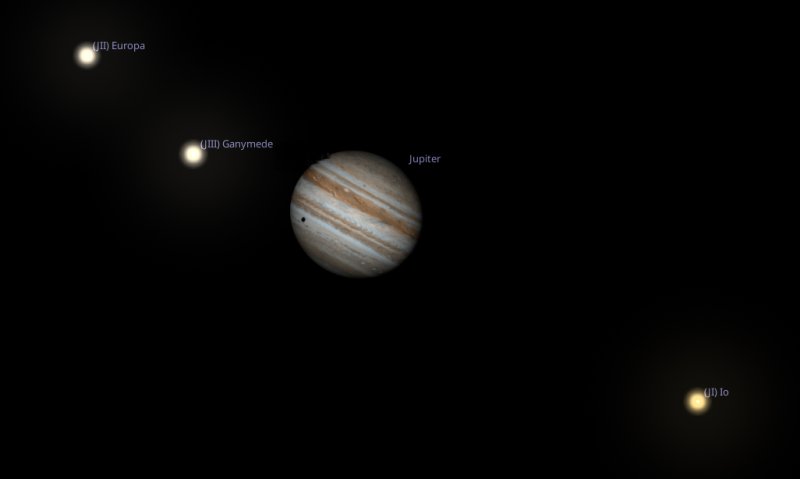 |
|
Look towards the west again at 3am in the early hours of Thursday 4th to see a 98%-lit gibbous Moon occulting (or appearing to pass in front of) the Pleiades open cluster of stars, Messier 45. |
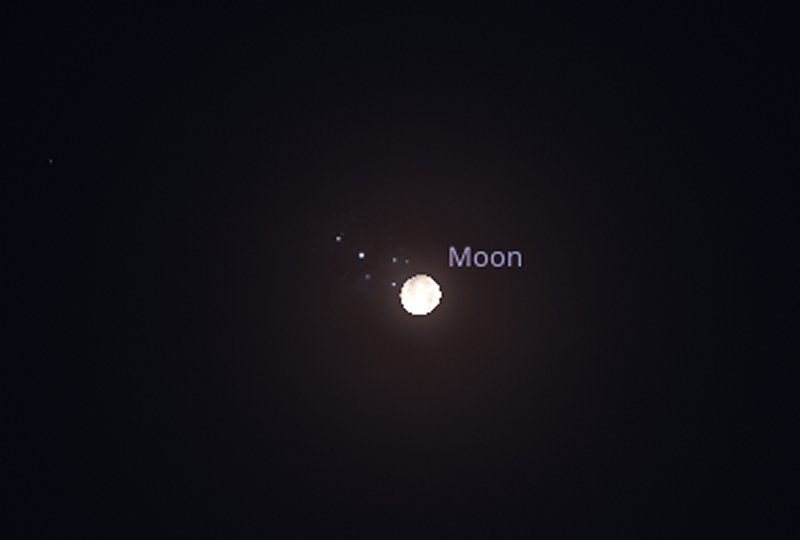 |
|
If that's a bit too much of an unsociable hour for you, pop back outside around 7pm on the Thursday evening and look towards the east, where you will find what has then become a Full Moon rising above the horizon. It will be just above the constellation of Taurus and heading towards the Pleiades again. This Full Moon occurs close to perigee, when the Moon is closest to us in its orbit around the Earth, so it will appear slightly larger than at other times, when it is at apogee and furthest away from us. |
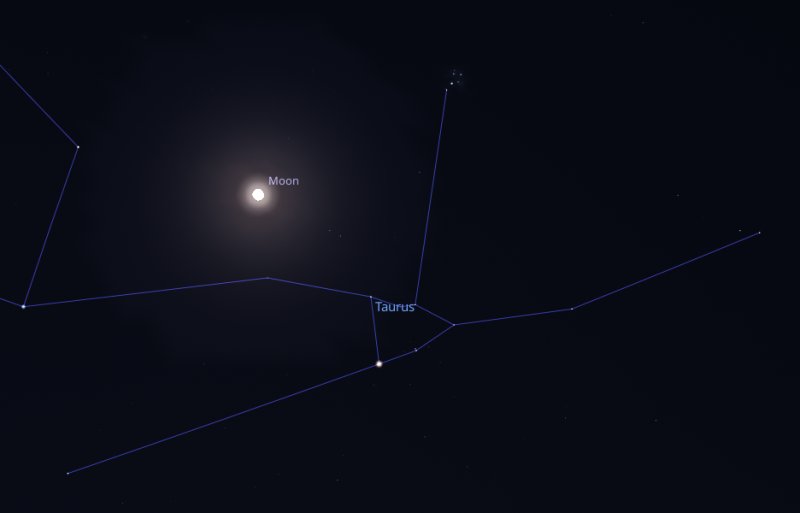 |
|
If you are up early on Sunday 7th, Mercury reaches its greatest elongation and will be 20 degrees away from the rising Sun, so this is an ideal opportunity to observe it. By 6.30am, the planet will have risen above the horizon towards the south east. |
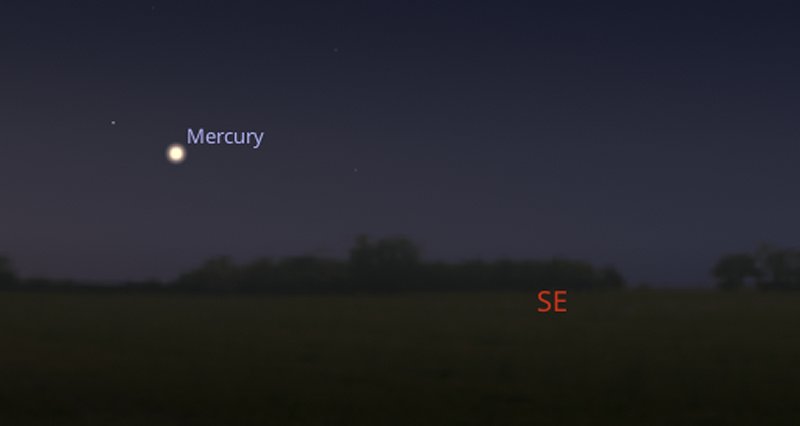 |
|
Please don't be tempted to use binoculars or a telescope to obtain a better view though, because the Sun will be appearing in the same place shortly afterwards and you mustn't risk catching even the tiniest glimpse of it in your eyepiece! |
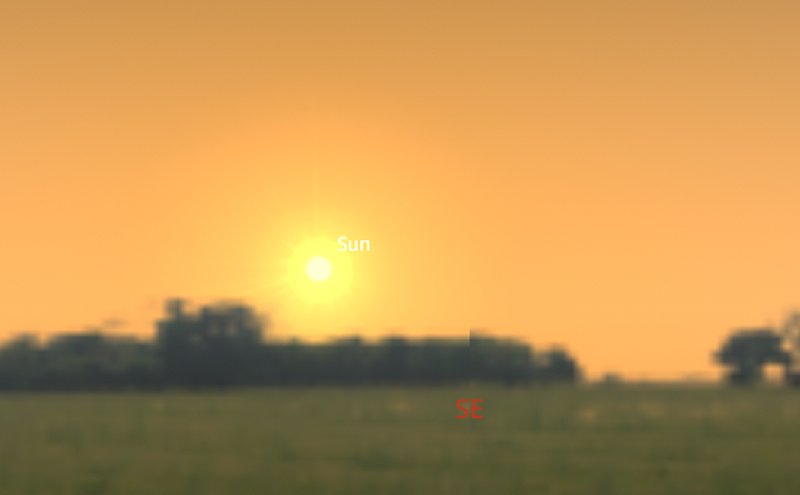 |
| Monday 24th to Sunday 30th November 2025 |
|
Last week I mentioned the shadows of two of Jupiter's moons, Io and Callisto, being cast on to the planet's surface. This coming week, it is the turn of another moon, Ganymede, to do the same. The Galilean moon's shadow can be observed between about 2am and 5am on Tuesday 25th and at 2am, you would be needing to aim your telescope towards the south east to catch it. |
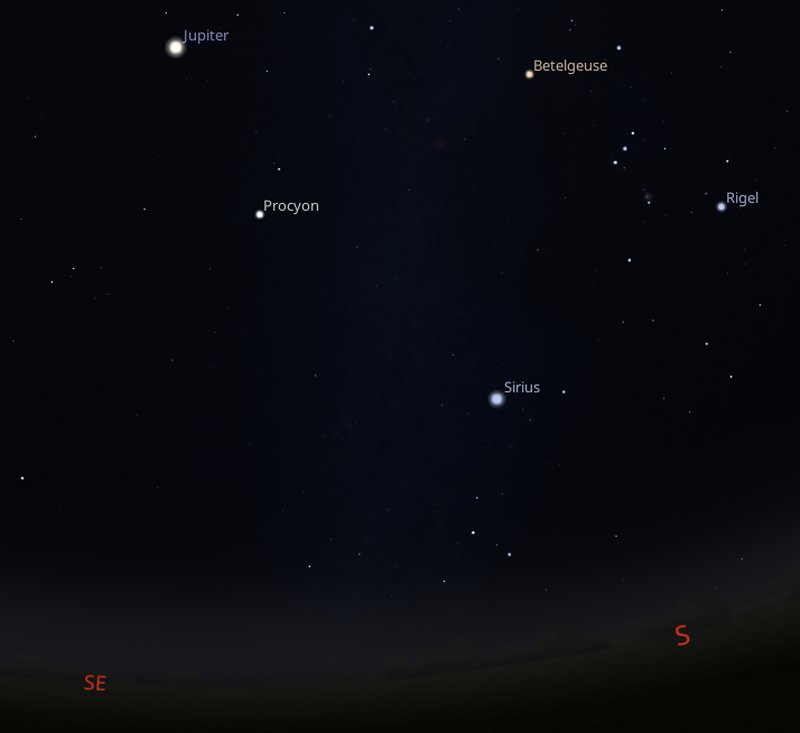 |
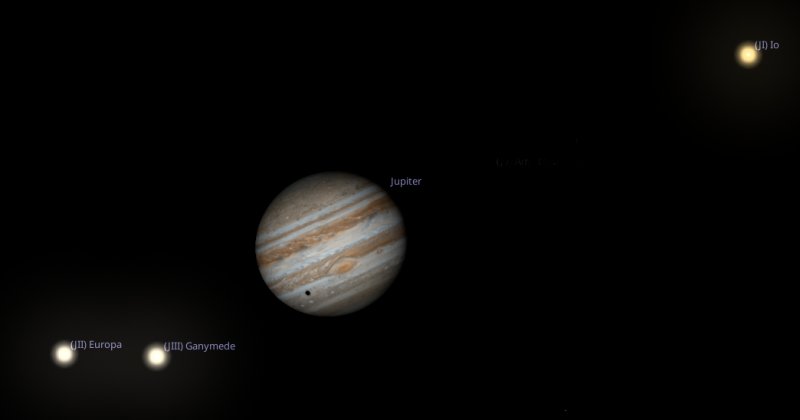 |
|
If at the same time, you look to the right of Jupiter and a little below it, you will be able to see the bright star, Procyon and the brightest star in the night sky, Sirius. To the right of them, the constellation of Orion will be easy to find. |
|
Why not have a go at spotting the Great Orion Nebula M42, located in the "sword" of Orion while you are there. M42 is classed as an "emission" nebula where light is radiated from its gasses and it is where stars are born. The nebula is about 1600 light years away from us, so if you observe it next week with your telescope, you will actually be seeing the nebula how it looked 1600 years ago! |
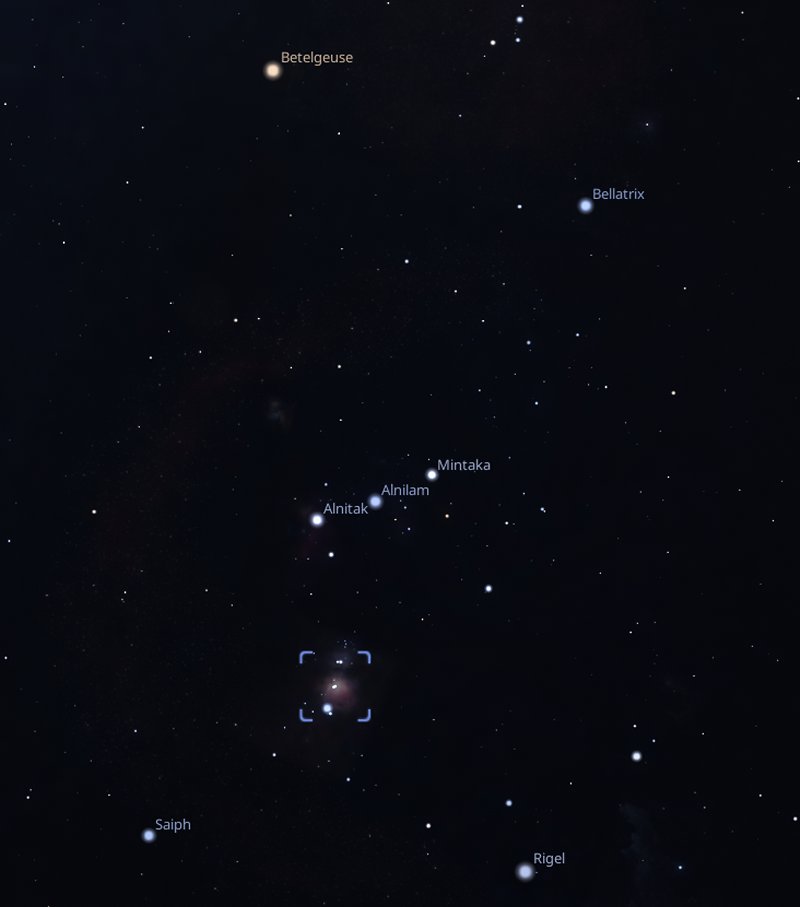 |
|
If that sounds amazing and you would like to learn more, the first of my astronomy talks and star parties for this season will be taking place at the Ham Hill Visitor Centre on the evening of Friday 28th November. There will be a one-hour talk about the night sky at 7pm and then if it is clear, we venture outside. Places always fill quickly, so booking is essential via the Ham Hill Rangers Office on 01935 823617. |
|
The following evening, Saturday 29th, it should be possible to observe a 65%-lit waxing gibbous Moon close to Saturn if you look towards the south west around 9pm as the pair set below the horizon. |
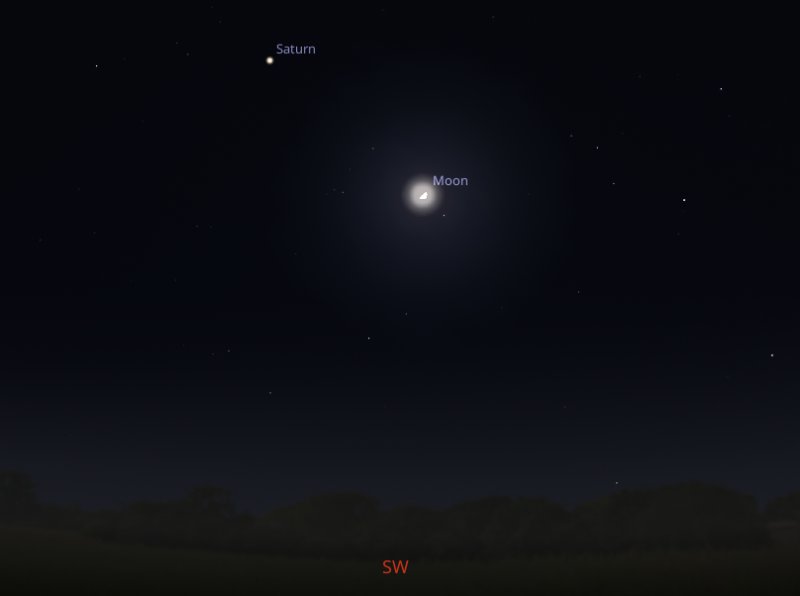 |
| Monday 17th to Sunday 23rd November 2025 |
|
The evening of Monday 17th sees the peak of the annual Leonids meteor shower, with the actual peak occurring at 6pm. Around the peak, the shower can produce up to 15 shooting stars per hour - this is known as the Zenithal Hourly Rate. |
|
However if you go outside at that time, you won't see a thing, as the constellation of Leo (where the radiant point of the shower is located, near the lion's head) will still be below the horizon. You will need to stay up late, when the constellation appears above the eastern horizon from after midnight on the Tuesday morning. |
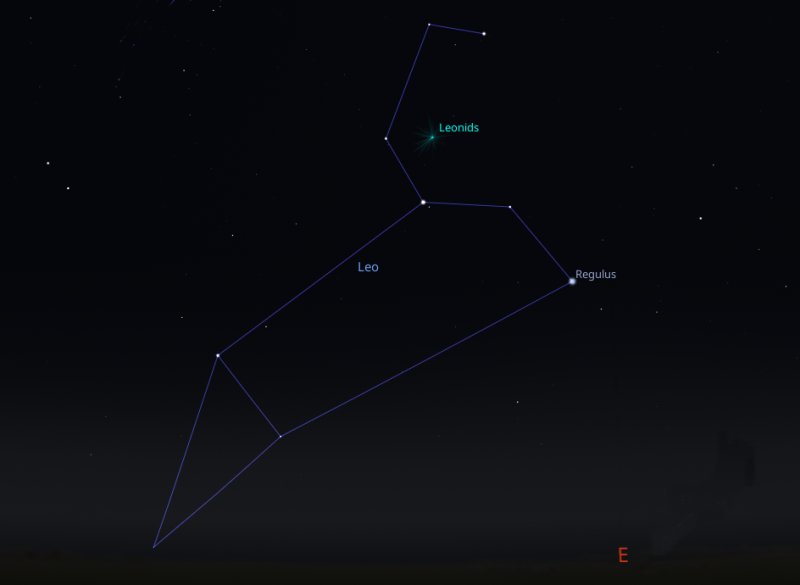 |
|
That's close enough to the peak and as a bonus, there will be no light pollution from the Moon, which will still be well-below the horizon. Of course you don't need a telescope to see the spectacle, but if you want to do a bit more exploring, Jupiter will be located a little above and to the right of Leo, with the constellation of Orion further to the right. |
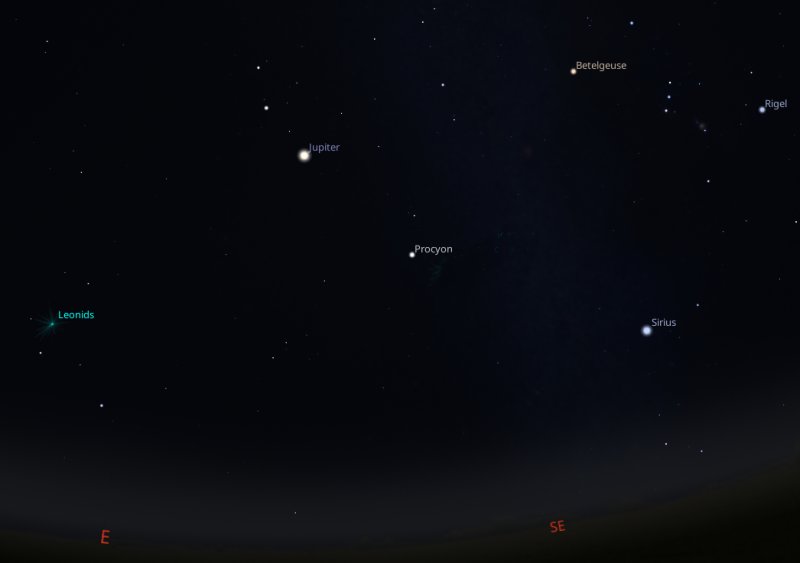 |
|
Aiming a telescope at Jupiter will often reveal its four Galilean moons, unless one of them is hidden orbiting around the other side of the planet at the time. Try looking at Jupiter around 2am on Friday 21st to catch the shadow of two of its moons, Io and Callisto, simultaneously being cast onto the planet's surface. At that time, Jupiter will be found towards the east again, like on the Monday night and you should be able to see all four moons - the exact same sight that Galileo witnessed back in 1610 when he first-realised that the moons were orbiting around the planet - back then, everyone thought that all heavenly bodies circled the Earth! |
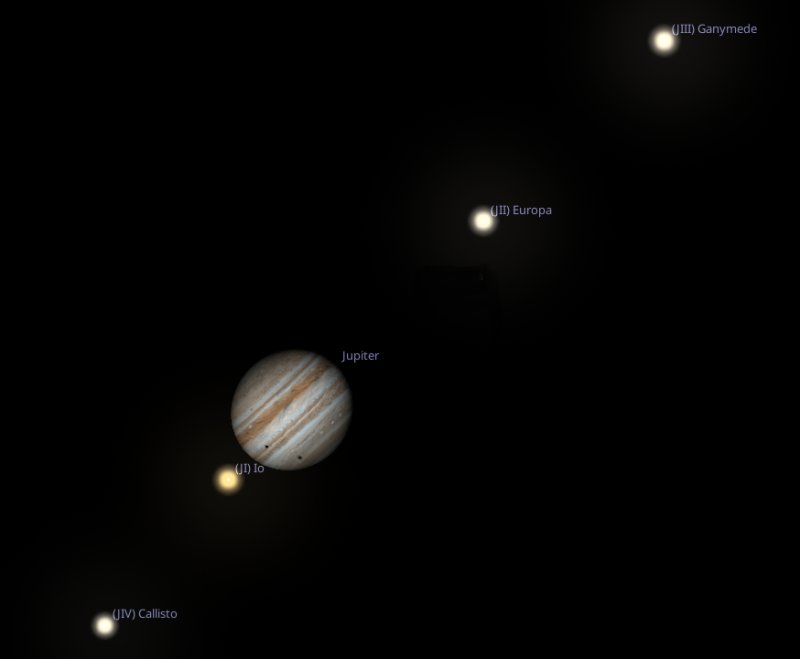 |
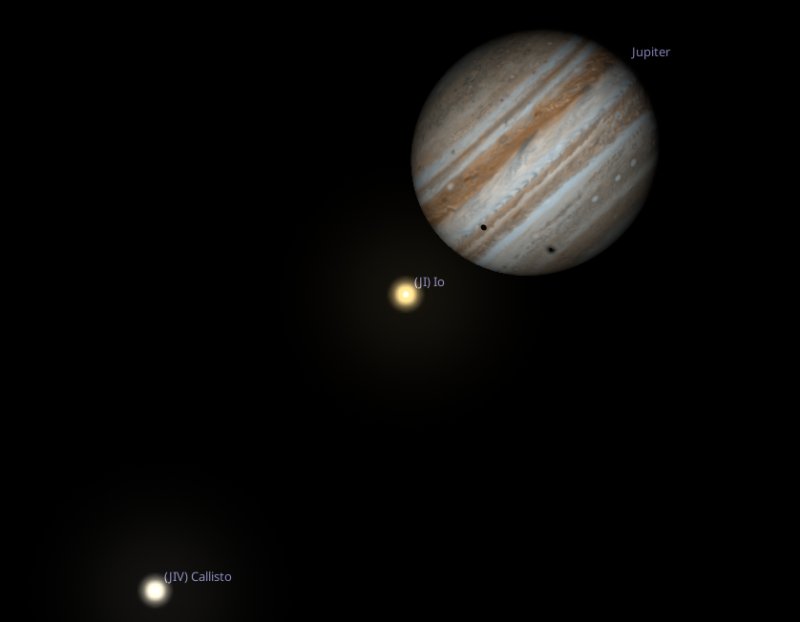 |
| Monday 10th to Sunday 16th November 2025 |
|
If you look towards the south west at 6am on Monday 10th, the constellation of Orion with its bright stars Betelgeuse and Rigel will be easy to spot. To the left of Orion will be the brightest star in the night sky, Sirius, that has a magnitude of -1.44 while a little above Sirius, you will find another bright star called Procyon. Procyon is actually a double star with a magnitude of +0.4 |
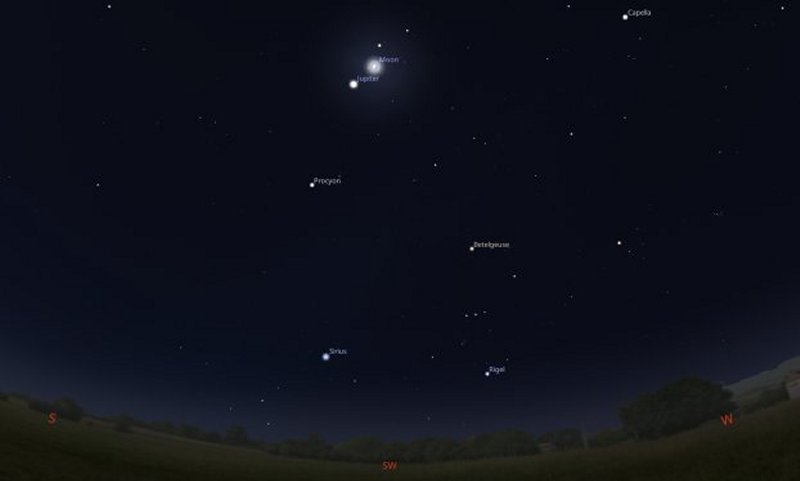 |
|
Look above Orion to see something even more obvious.....a 71%-lit waning gibbous Moon extremely close to Jupiter. Note that the Moon is a little to the right of Jupiter. |
|
All of these targets will be easy to spot with the naked eye, so no telescope necessary! |
|
Look again at the same time and in the same direction the following morning, Tuesday11th and everything will appear to be in near-enough the same place, except that the Moon will now be a 60%-lit gibbous shape and it will be located to the left of Jupiter. This is because the Moon is orbiting around us, so it appears to move completely differently to everything else in the night sky. |
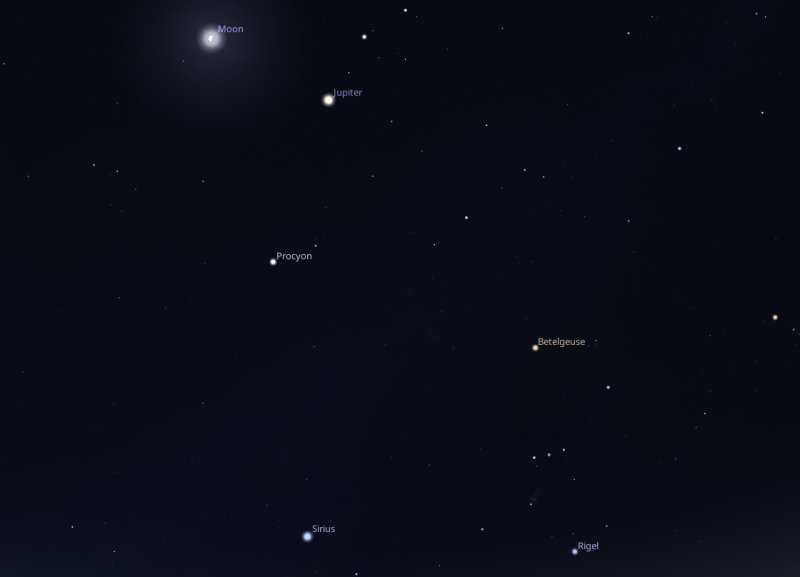 |
|
If you're really feeling the urge to dig out that telescope, just below the Moon, you could try to spot the Beehive open cluster of stars which is M44 in the Charles Messier catalogue, but the view is likely to be disappointing because of the light pollution created by the Moon. |
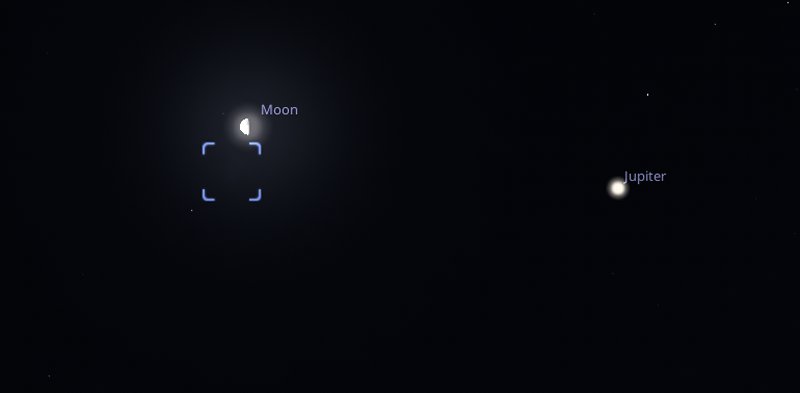 |
| Monday 3rd to Sunday 9th November 2025 |
|
Back on 7th October we had a Supermoon, so named because the Full Moon occurred close to perigee, when our natural satellite was closest to us in its orbit around the Earth. At that point, it appeared 14% larger than when it's furthest from us, at apogee. On Wednesday 5th November, we have the next Full Moon and once again, it will be very close to perigee. At 7pm, the Moon will be located towards the east. |
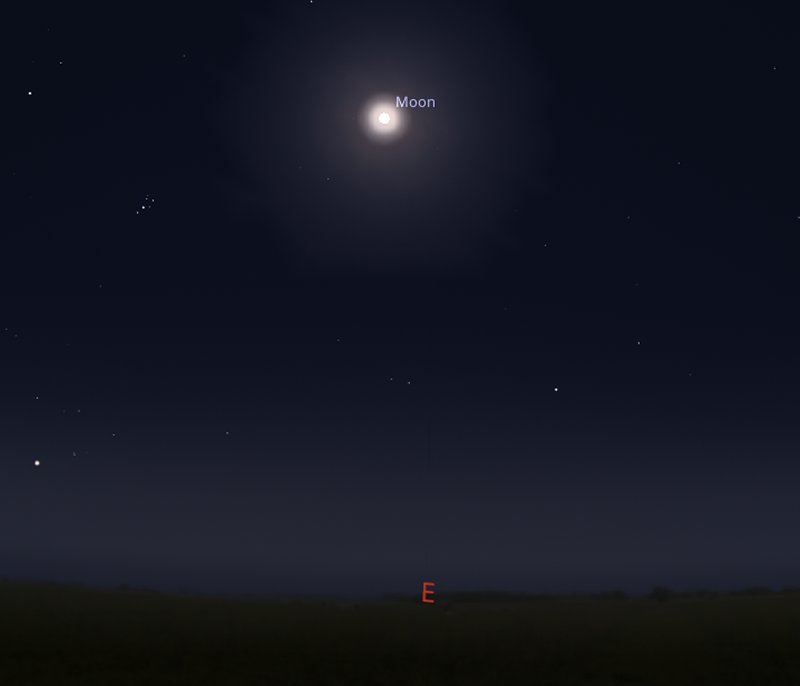 |
|
To use the correct astronomical terms, rather than saying "14% larger", the Moon will appear to have an apparent diameter of 33.3 arcminutes as opposed to 31.0 arcminutes. What on Earth does that mean? An arcminute is one sixtieth of a degree. An arcsecond is one sixtieth of an arcminute. These units are used to measure very small angles in science fields. Quite logical, but personally, I think "14% larger" is a lot easier to understand! |
|
I didn't mention comet C/2025 A6 Lemmon last week because you probably wouldn't have been able to see it! Remember that from a very dark location, you can resolve objects down to a magnitude of around +6.0 with the naked eye. Binoculars or a very small telescope will enable you to spot things down to a magnitude of +8.0 and for anything fainter than that, it is serious telescope time. The comet was predicted to have a magnitude of only around +10, but comet brightness is notoriously hard to predict and in the end, some people observed it around +4.0 |
|
The press is reporting comet 24P/Schaumasse passing through the Beehive Cluster M44 next week, but don't get too excited, because this comet will have an estimated magnitude of +14.3 so will be even dimmer! |
| Monday 27th October to Sunday 2nd November 2025 |
|
This coming week, we have a period of occultations. Sounds like some series of sinister black magic rituals, but in astronomy terms, an occultation occurs when one celestial body hides another. |
|
On the evening of Wednesday 29th, our target is Saturn. Aim your telescope towards the gas giant a bit before 8.30pm, when it will be located towards the south. |
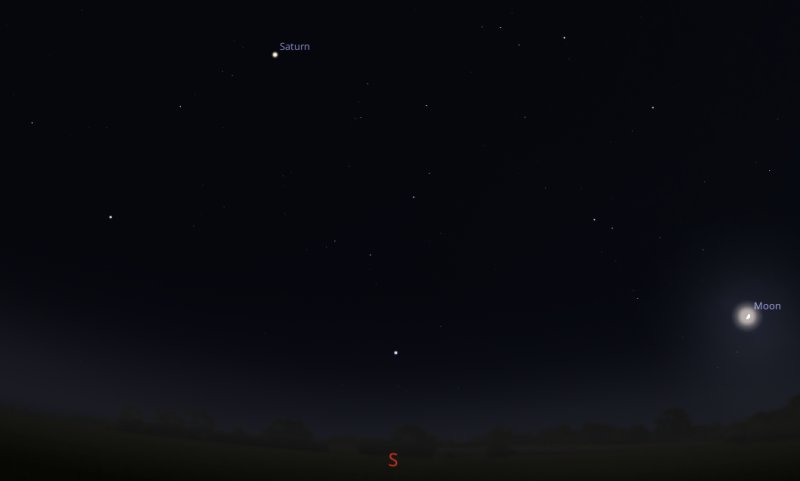 |
|
Although Saturn's dust rings are not currently well-placed for observing, a number of its many moons will be obvious. Keep watching and you should be able to see the largest of Saturn's Moons, Titan, being gradually occulted by the planet. |
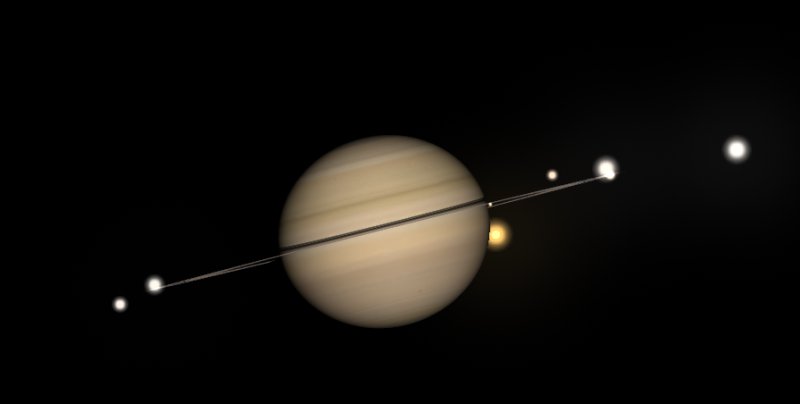 |
|
The following evening, Thursday 30th, look towards the south west at 10pm to see a 62%-lit waxing gibbous Moon against the backdrop of the constellation Capricorn. The Moon will be getting close to the magnitude +3.7 star Nashira in the constellation. Just before 10.30pm, the Moon occults Nashira. |
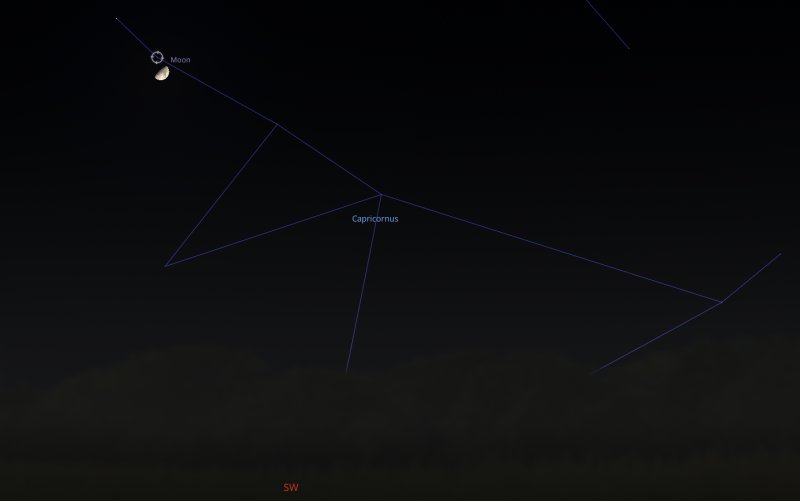 |
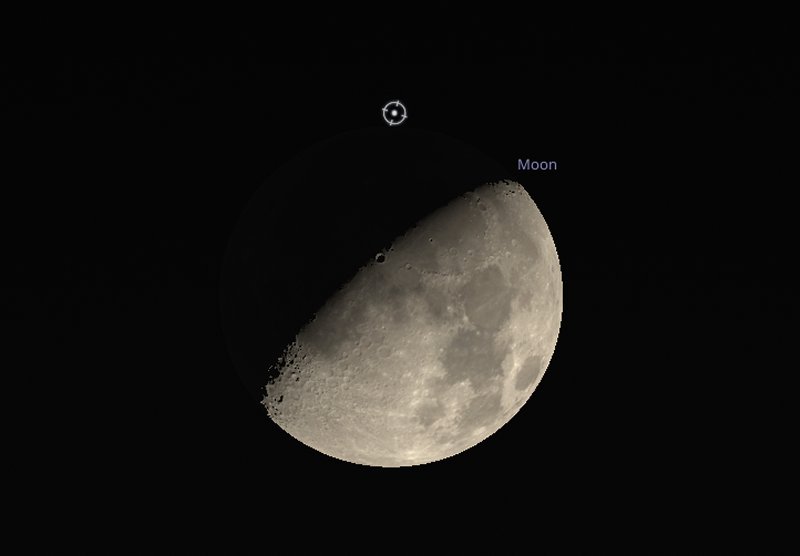 |
|
Remember that the Moon appears as a disc, but being in a gibbous phase, you can only see 62% of the surface facing us lit by sunlight. This means that Nashira will disappear before the illuminated part of the Moon gets to it and at the beginning, it is occulted by the dark bit of the Moon's surface that you can't actually see! |
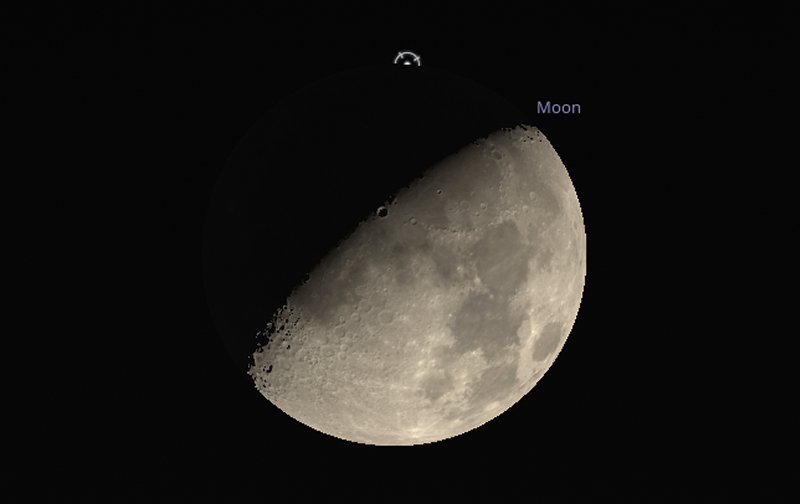 |
|
You won't get this effect with the Titan occultation because planets that are further away from Sun than us don't exhibit phases and we always see them as single points of light. |
| Monday 20th to Sunday 26th October 2025 |
|
Tuesday 21st is the peak of the annual Orionids meteor shower, so named because the radiant point where the shooting stars appear to originate from is close to the constellation of Orion. |
|
If you go outside from around 11pm. Orion will have risen above the horizon to the east and the radiant point of the shower will be a little to the left of the red giant star Betelgeuse. While you are waiting for those streaks of light to appear, further to the left, Jupiter will be easy to spot. |
 |
|
As a bonus, that evening coincides with a New Moon, when the side of the Moon facing us is not illuminated at all by sunlight, so there will be no light pollution from our celestial neighbour to spoil the view. |
|
Meteor showers are caused by the Earth scooping up the debris left by comets while they travel close to the Sun on their long journey from the outer reaches of our Solar System. As we orbit around the Sun, these showers occur at the same time every year. In the case of the Orionids, they are caused by bits left behind from comet Halley. |
|
The shower has a zenithal hourly rate in excess of 20 meteors per hour, so you shouldn't be waiting too long before you see something and if you can't make Tuesday 21st, observing a couple of days before or after the peak should still produce some results. |
|
Finally, an early reminder that the first of my astronomy talks and star parties for this season will be taking place at the Ham Hill Visitor Centre on the evening of Friday 28th November. There will be a one-hour talk about the night sky at 7pm and then if it is clear, we venture outside. Places always fill quickly, so booking is essential via the Ham Hill Rangers Office on 01935 823617. |
| Monday 6th to Sunday 12th October 2025 |
|
If you pop outside just as it's getting dark on the evening of Tuesday 7th, say around 7pm and look towards the east, a Full Moon will be rising above the horizon, with Saturn visible a little to the right of it. |
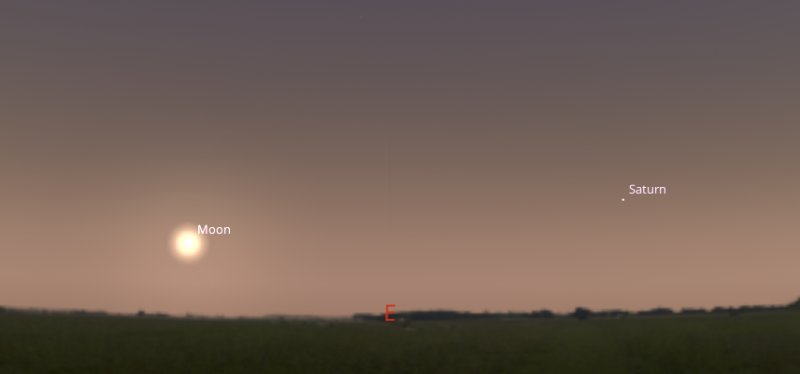 |
|
A Full Moon reflects so much sunlight that it creates the ultimate natural light pollution and this will spoil your view of Saturn a bit. It is also the worst possible time to go hunting for faint deep sky targets. |
|
We have just passed the autumn equinox and as this Full Moon is the closest to that date, it is known as the 2025 Harvest Moon. Coincidentally, this particular Full Moon occurs at perigee, when our celestial neighbour is closest to us in its orbit around the Earth. |
|
In astronomy, there is no such thing as a perfect circle and all objects' orbits are elliptical (or egg-shaped) to a greater or lesser degree. In the case of our Moon, at perigee our natural satellite is approximately 225,000 miles away from us, where at the opposite point in its orbit, known as apogee, it is more like 251,000 miles away. This cycle repeats every 27 days, which is how long the Moon takes to go around us. |
 |
|
The Moon appears slightly larger when it is at perigee and the difference is size between the two extremes is about 14%. If a Full Moon occurs at perigee, it is known as a Supermoon. So on 7th, we really have a Harvest Supermoon! |
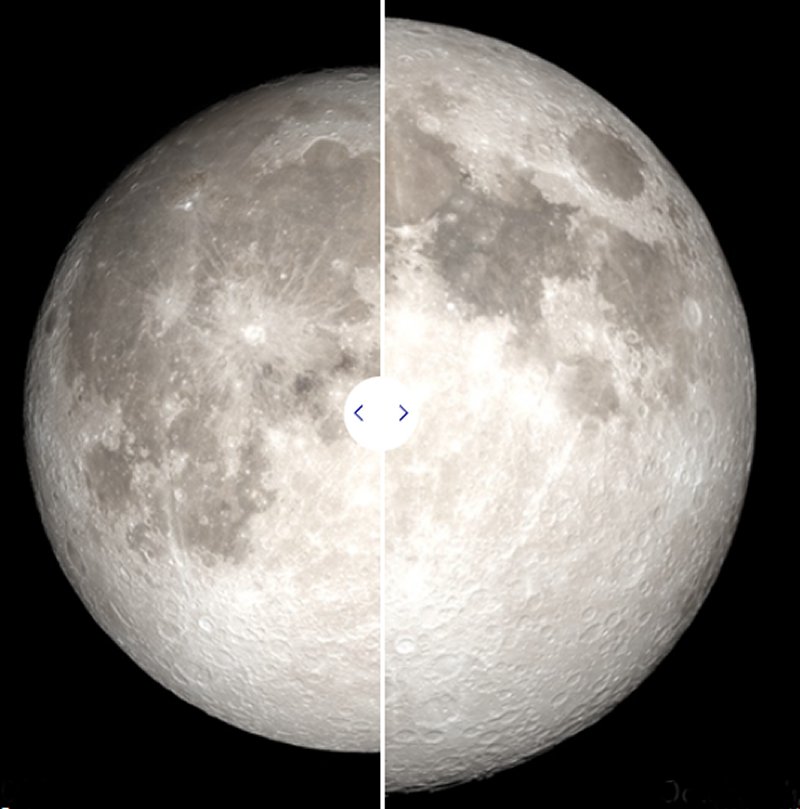 |
|
Because the Moon will be close to the horizon when you view it, you may also witness that phenomenon known as "Moon Illusion" where your eyes play a trick on you and make it appear artificially large. |
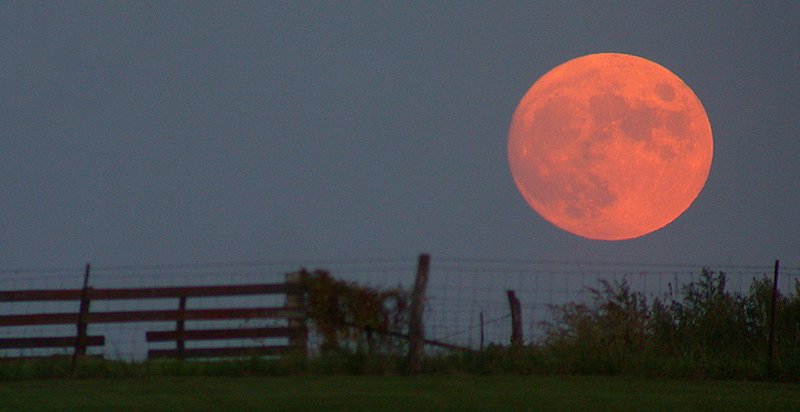 |
| Monday 29th September to Sunday 5th October 2025 |
|
If you venture outside at 1am on Monday 29th September and look towards the east north east, Jupiter will have just risen above the horizon. To the right of the gas giant, you should also be able to make out the constellation of Orion more towards the east and again, close to the horizon. |
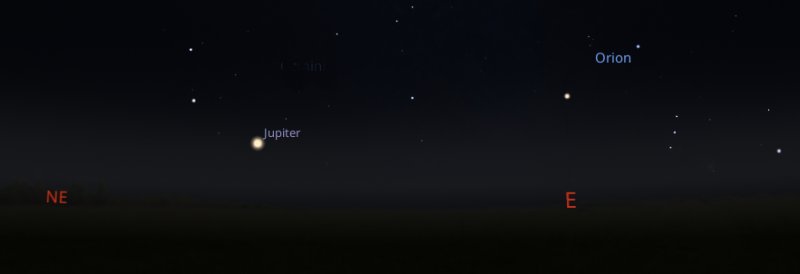 |
|
Why 1am specifically? Well if you aim your telescope towards Jupiter at that time, it should be possible to witness the shadow of the planet's moon Io cast onto its surface, while at the same time, another of Jupiter's moons, Ganymede, is physically passing in front of the planet. At 1am, Ganymede and the shadow of Io will appear to be either side of Jupiter's Great Red Spot. |
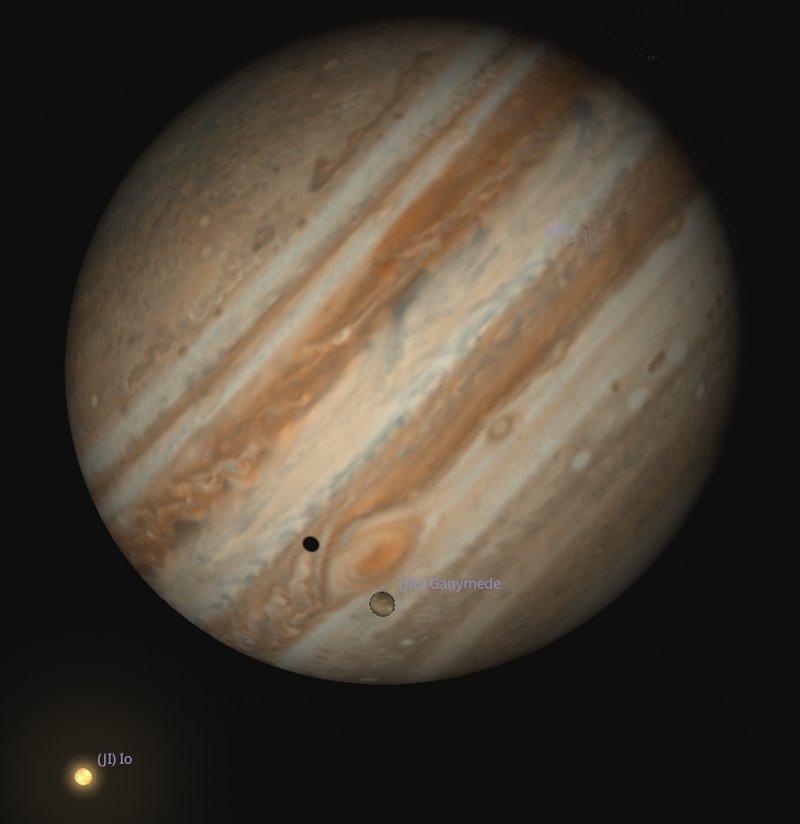 |
|
The Great Red Spot is a giant storm in Jupiter's upper atmosphere that has been blowing for hundreds of years. It measures about 10,000 miles across, so is about the size of the whole Earth and has wind speeds of over 250 miles per hour! It keeps going because Jupiter has no planetary surface that would cause friction to slow it down. Often, when you look at Jupiter through a telescope, you don't see the Great Red Spot at all. This is because it only takes ten hours for the storm to rotate completely around the planet, so it's often round the other side! |
 |
| Size comparison image courtesy of NASA |
|
Look towards the south around 1am on 2nd October and Saturn will be an easy target to spot. To the left of Saturn will be the large constellation of Cetus and with your telescope, you could try to find the dwarf planet Ceres that lives in the Asteroid Belt - it will be just to the right of Cetus with a magnitude of around +7.6 |
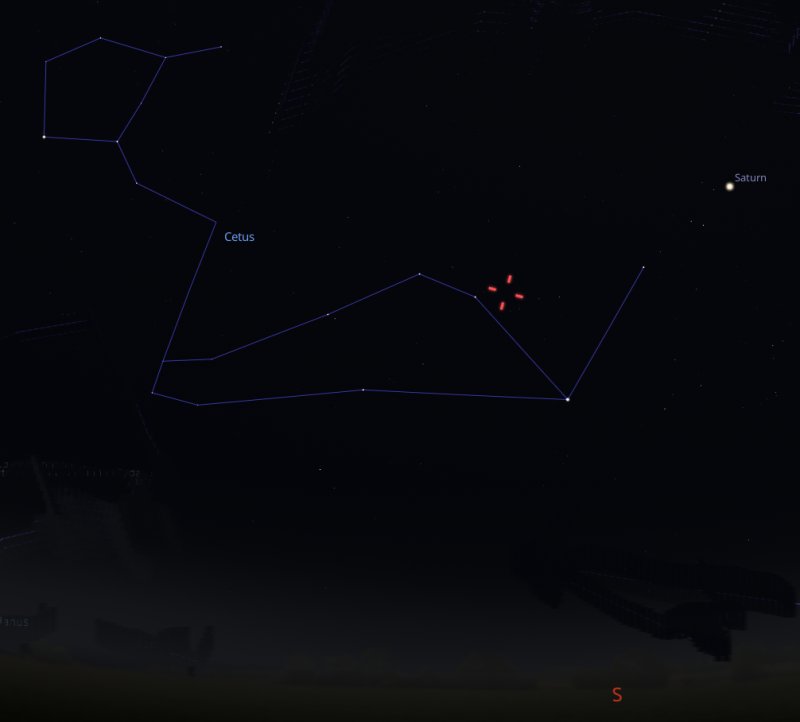 |
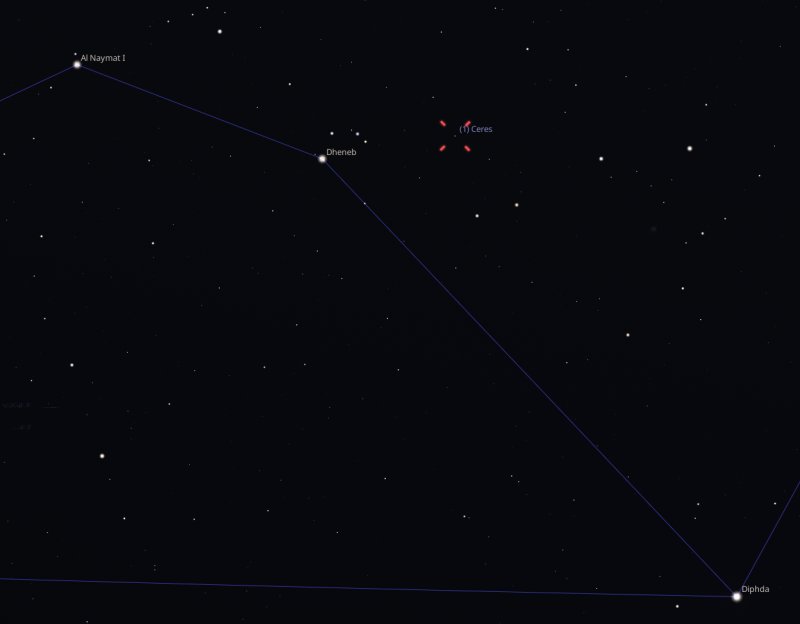 |
| Monday 22nd to Sunday 28th September 2025 |
|
Monday 22nd is the autumn equinox. This translates to "equal night and day" and is the point in our orbit around the Sun where the Earth's 23.5 degree tilt is sideways on to the Sun. The same happens again six months later of course, when we have the spring equinox. In between these times, the northern hemisphere is either pointing away from the Sun or towards it and we have winter or summer. |
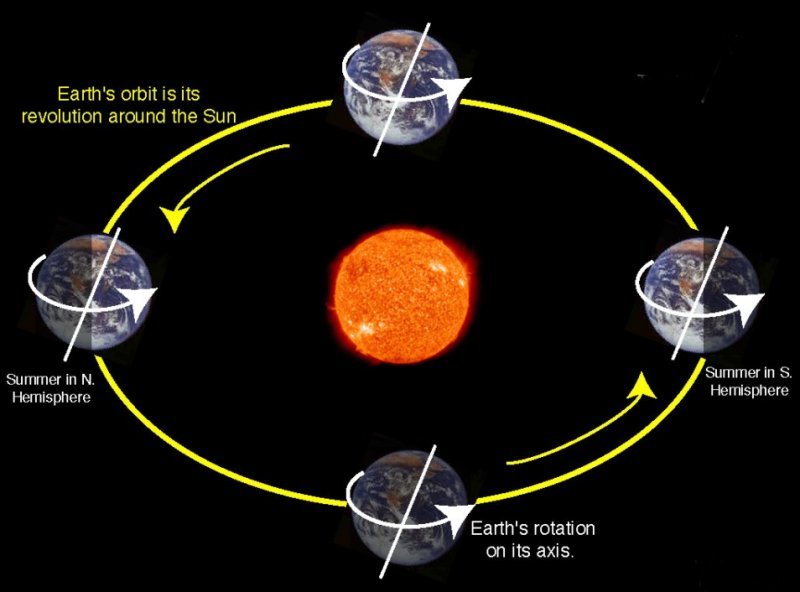 |
|
Last week, I mentioned about Saturn being viewable throughout the night as it appears to travel from east to west horizons. This week, if you dig out your telescope to have a better look at the gas giant, it should also be possible to spot Neptune just above and to the left of Saturn. |
|
Pop outside any evening next week, around 10pm - Saturn will be located towards the south east and easy to spot, shining at a magnitude of around +0.6 while Neptune will be a much harder target at a magnitude of only +7.7 making it invisible to the naked eye. |
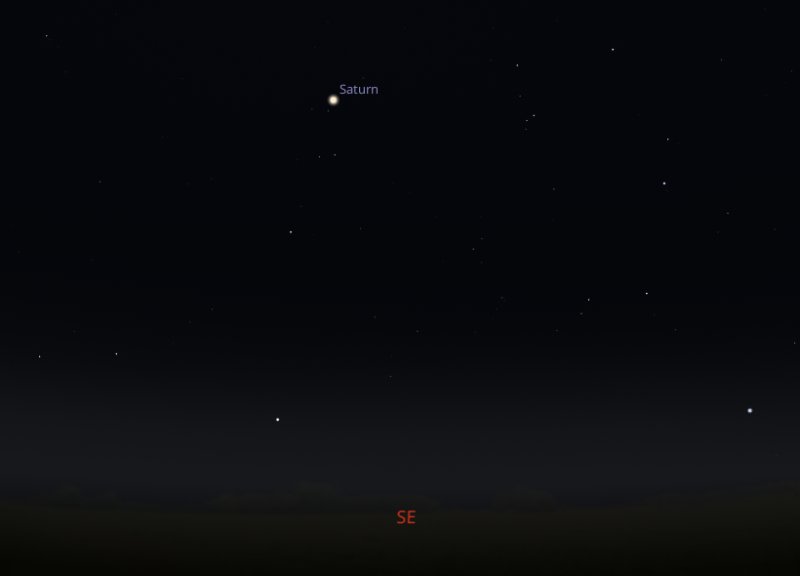 |
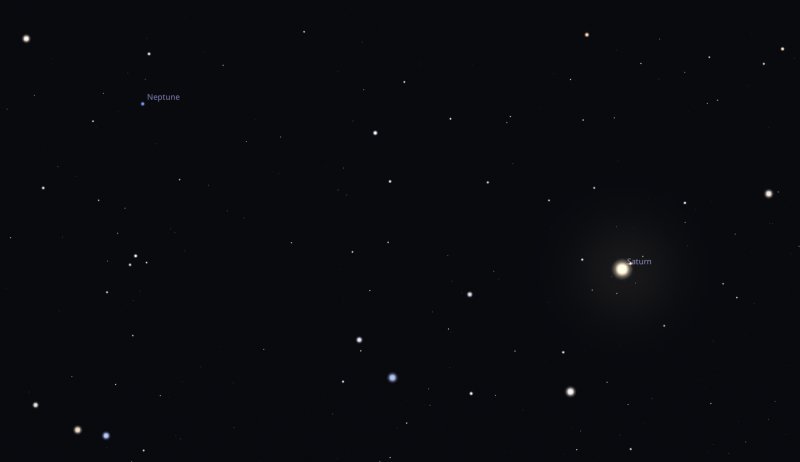 |
|
Venture back outside at 6am on Saturday 27th and Jupiter will be quite high in the sky towards the south east, with a very bright planet Venus rising above the horizon in the east. |
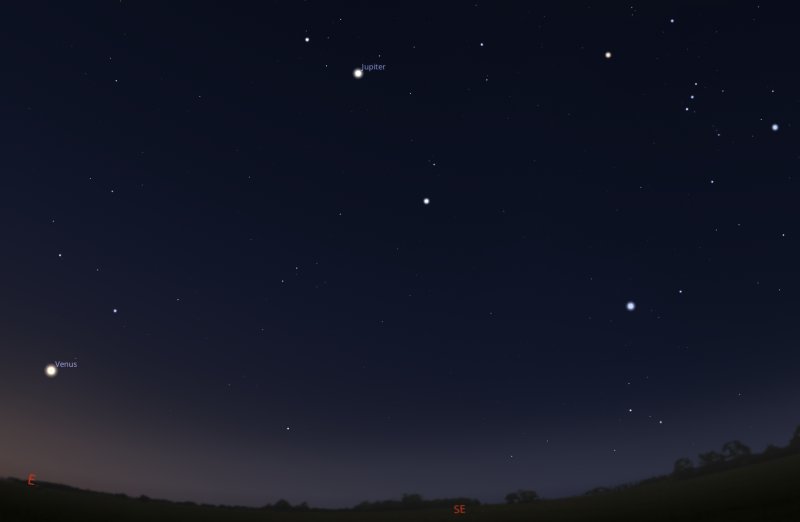 |
|
Why have I chosen 6am on the Saturday specifically? Well if you aim your telescope towards Jupiter then, it will be possible to see the shadow cast by two of Jupiter's moons, Io and Europa, at the same time. How cool is that! |
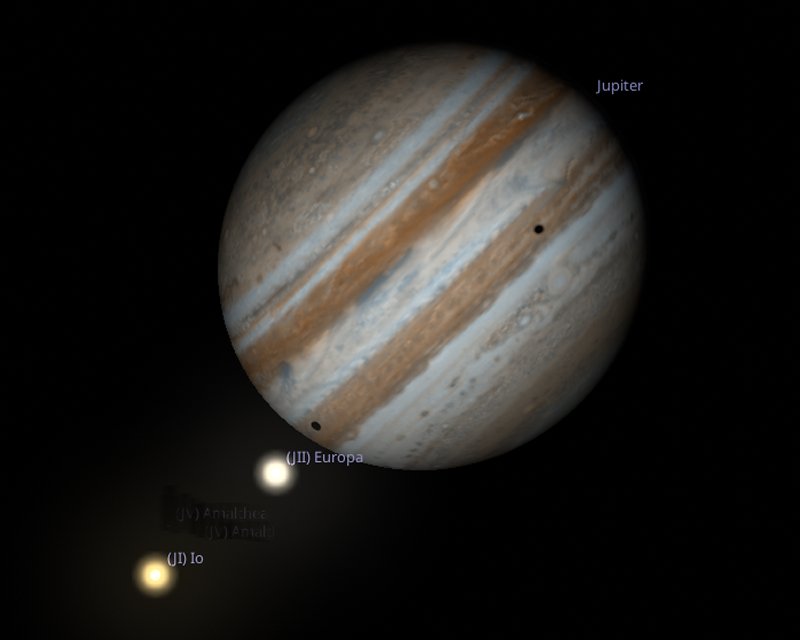 |
|
Please remember to pack your telescope away before the Sun rises though, as catching an accidental glimpse of that in your eyepiece would most definitely NOT be cool! |
| Monday 15th to Sunday 21st September 2025 |
|
We always associate astronomy with the night sky, but it is possible to observe some brighter objects during the day, with our Moon being the most obvious target. |
|
Look towards the south west around 11am on Tuesday morning 16th and try to spot a 28%-lit waning crescent Moon with the naked eye. It will be quite high in the sky - about 55 degrees above the horizon. If you have brought your telescope out, just below and to the left of the Moon, Jupiter will be shining at a magnitude of -1.9 |
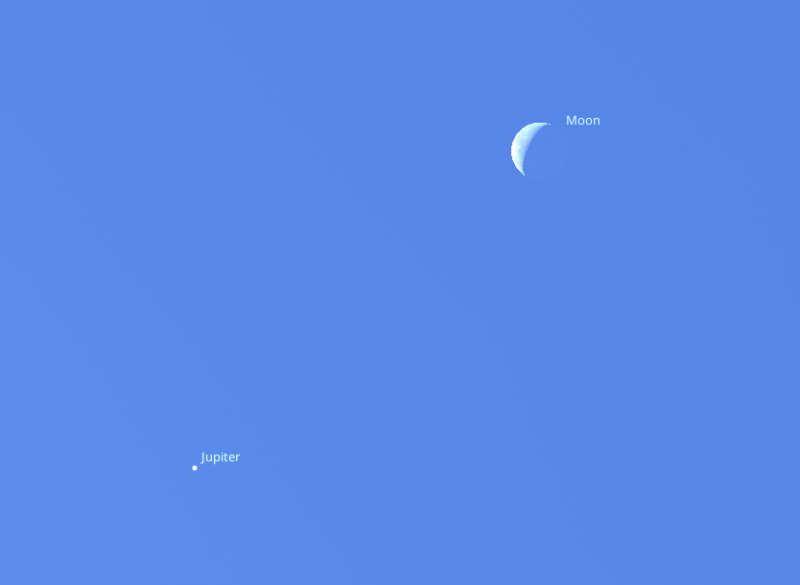 |
|
I will repeat my usual warning though, that the Sun will be shining very brightly at a magnitude of around -26.0 a little further south and you must never accidentally catch a glimpse of it in your telescope's eyepiece, as it would result in instant and permanent blindness! |
|
Moving on to the morning of Friday 19th, look towards the east at 6am to see a 6%-lit crescent Moon. Just below the Moon, Venus will be easy to spot at a magnitude of -3.8 and immediately below Venus, you should be able to see the magnitude +1.0 bright star Regulus. |
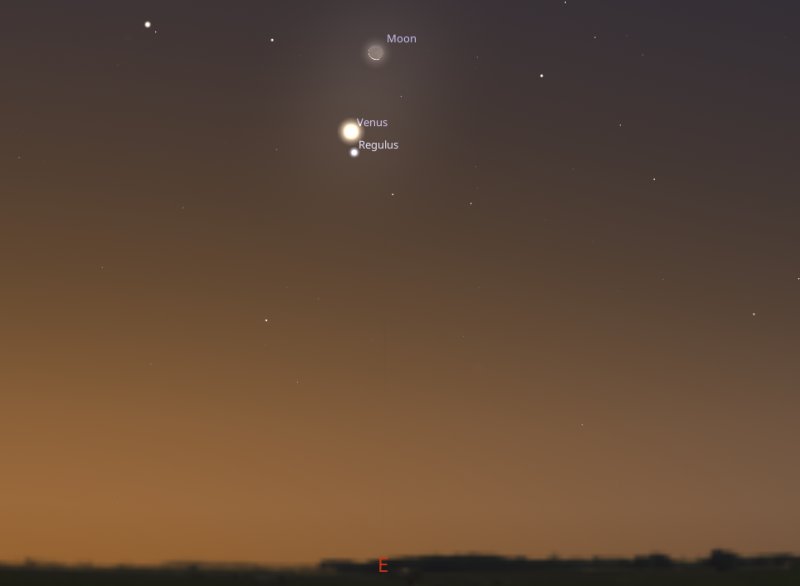 |
|
Don't even bother risking your telescope for this one, as the Sun will be just about to rise above the horizon in the same place! |
|
Finally, towards the end of the week, Saturn reaches opposition and it will actually be viewable the whole night, from dusk to dawn, as it appears to travel between east and west horizons. |
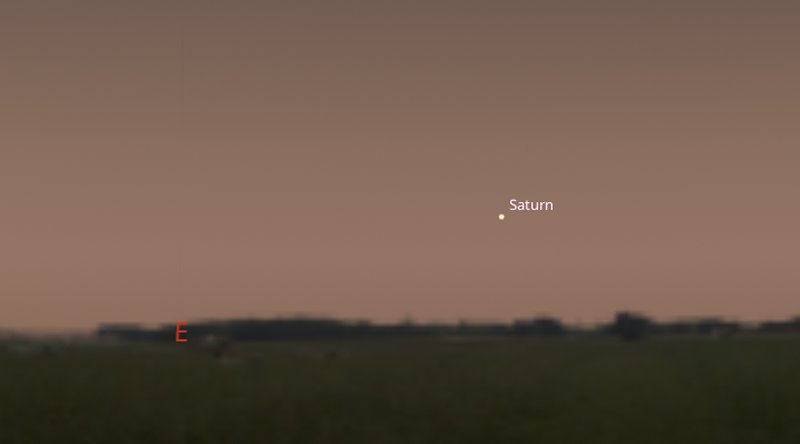 |
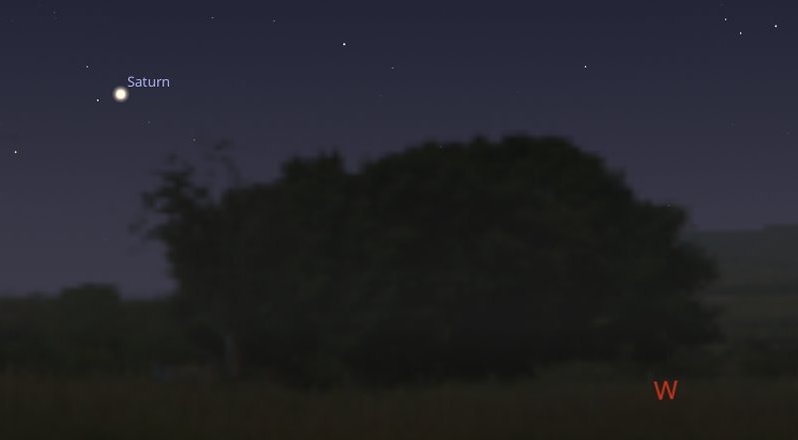 |
| Monday 8th to Sunday 14th September 2025 |
|
We will have had a Full Moon on Sunday 7th, so if you pop outside around 9pm on Monday 8th and look towards the east, you will see a 98%-lit waning gibbous Moon rising above the horizon, extremely close to Saturn. The gas giant will be just below and to the right of the Moon. |
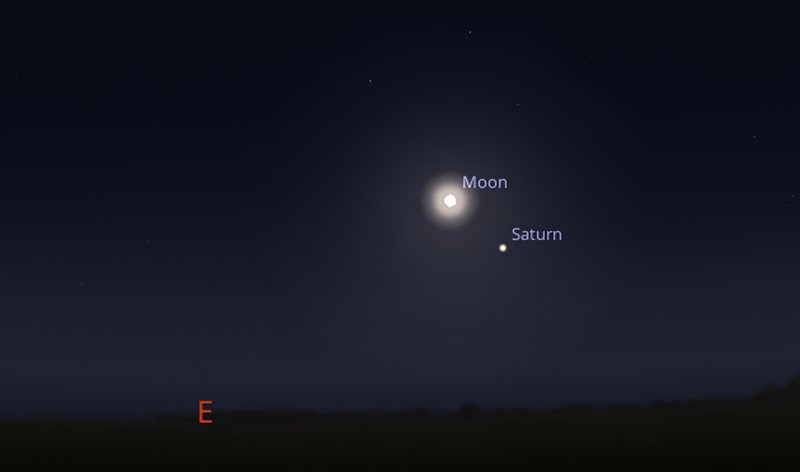 |
|
I wouldn't bother bringing your telescope outside as, being so close to a Full Moon, the light pollution from it makes for poor viewing of those elusive faint deep sky objects. |
|
One deep sky object that is always easy to spot though is the Pleiades open cluster of stars, also known as M45 in the Charles Messier catalogue and often called the "Seven Sisters" because of the seven prominent stars that can be seen with the naked eye. |
|
If you look towards the east north east at 9pm on Friday 12th, a slightly gibbous Moon will have just risen above the horizon and as it does so, the Moon occults (or appears to pass in front of) the Pleiades. |
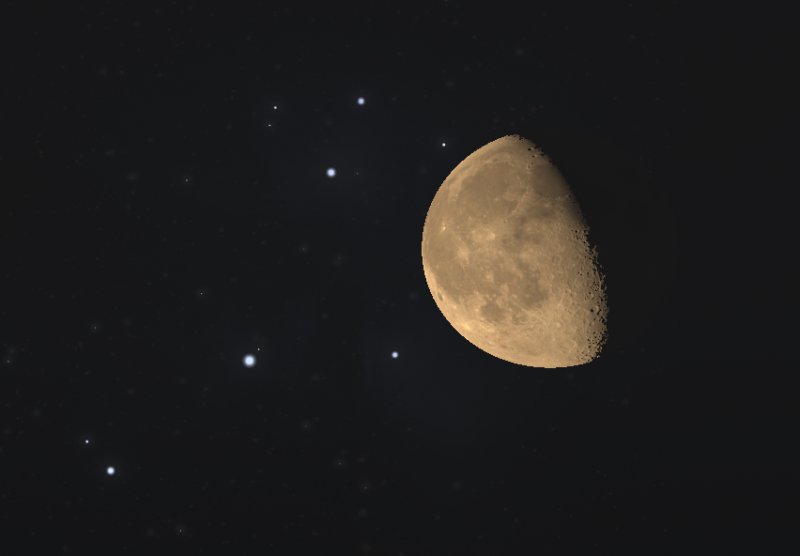 |
|
The Pleiades is the closest Messier object to us and is only 440 light years away. The bright blue stars that you see are relatively young and it is estimated that the cluster formed about 100 million years ago. If you are looking at them, remember that you will be seeing the stars how they were 440 years ago, as the light from them has taken that long to reach us, travelling at the speed of light, which is 186,000 miles per second! |
|
The stars are gradually drifting apart and in around 250 million years, the group will no longer be classed as a cluster, rather individual stars. |
| Monday 1st to Sunday 7th September 2025 |
|
The evening of Tuesday 2nd is the optimum time to spot the clair-obscur visual effects known as the "Lunar X and V", where sunlight falling on the Moon's surface reflects off particular features and creates recognisable shapes. |
|
Look towards the south south west around 11pm and the Moon will be about to set below the horizon. You will need your telescope to be able to spot the "X" and "V" shapes on the terminator between light and dark on the lunar surface. |
 |
|
A little to the right of the "V" you can find the dark area known as the "Sea of Tranquility" where Apollo 11 landed back in 1969. Of course there isn't really any water on the Moon, but early astronomers thought that the large dark, flat areas must be oceans and the names stuck. |
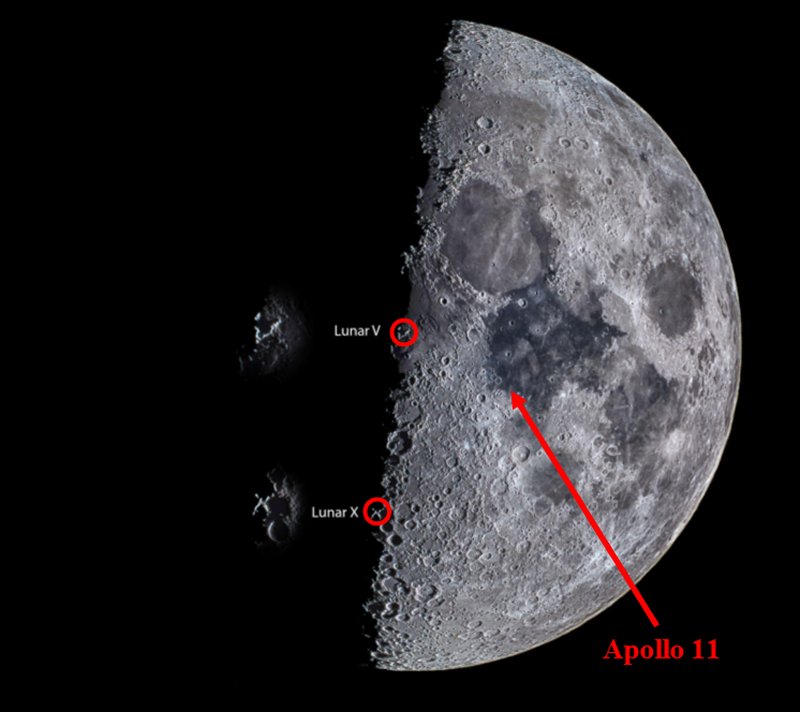 |
|
Sticking with our neighbour in the Solar System, but moving on to the evening of Sunday 7th, we have a lunar eclipse. As the Moon rises above the horizon at sunset, it is fully immersed in the Earth's shadow. |
|
Look towards the east at 7.45pm to catch the Moon popping its head above the horizon and at that time, it will appear quite dark because it is totally eclipsed - this is called "totality". |
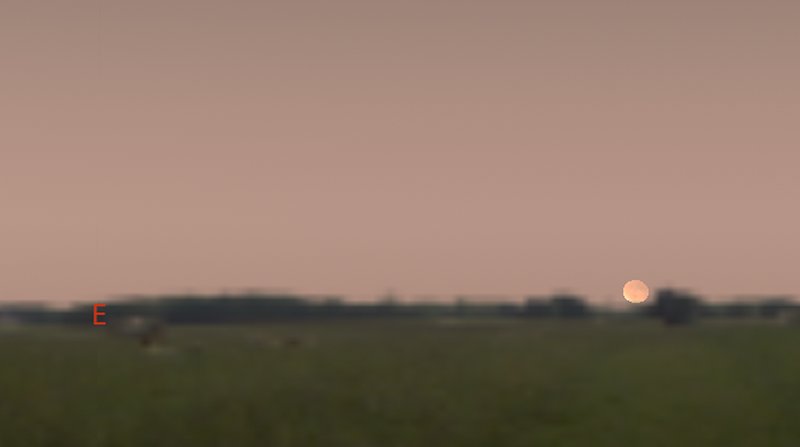 |
|
Gradually, over the following hour, as the Moon comes out of totality and rises in the sky, you will see more and more of its surface illuminated. If you are still watching it at 8.15pm, you will also be able to notice Saturn rising above the horizon in the same place. |
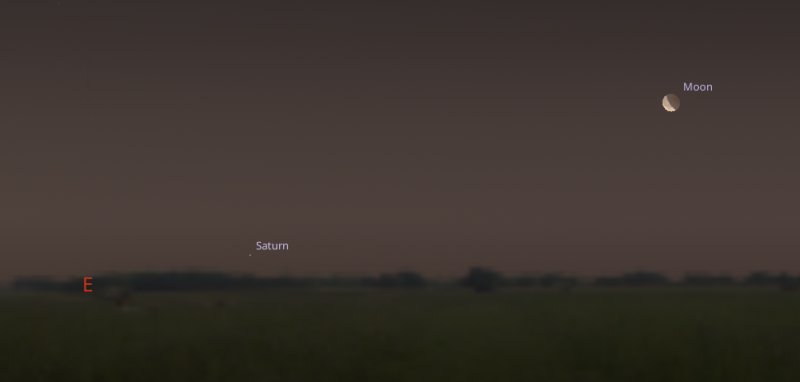 |
|
Screenshots courtesy of Stellarium |
|
Copyright Adrian Dening and Radio Ninesprings 2025 |
| To enquire about local astronomy talks and star parties |
| please contact Adrian Dening |
| 07545 641068 |
| info@starsoversomerset.com |
| Designed for 1024 x 768 resolution |